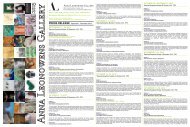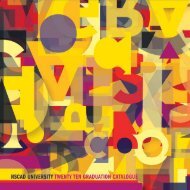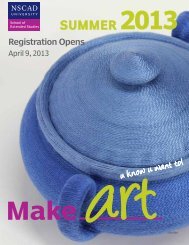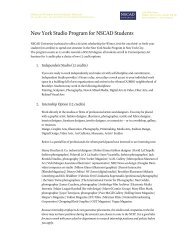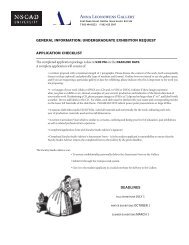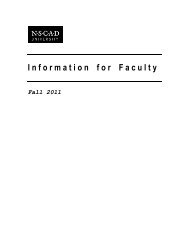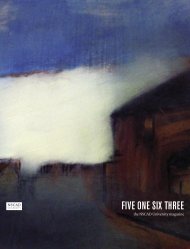Rethinking the Contemporary Art School - Nova Scotia College of ...
Rethinking the Contemporary Art School - Nova Scotia College of ...
Rethinking the Contemporary Art School - Nova Scotia College of ...
Create successful ePaper yourself
Turn your PDF publications into a flip-book with our unique Google optimized e-Paper software.
92 | <strong>Rethinking</strong> <strong>the</strong> <strong>Contemporary</strong> <strong>Art</strong> <strong>School</strong><br />
artist has displaced into a new situation, one that is <strong>the</strong>n given to <strong>the</strong> “viewer”<br />
to be reconsumed.<br />
Ano<strong>the</strong>r problem with <strong>the</strong> cultural <strong>the</strong>ory (relational aes<strong>the</strong>tics) model is<br />
that it enacts a simple dialectical reversal <strong>of</strong> Kantian modernist studio practice,<br />
one that was founded on <strong>the</strong> notion <strong>of</strong> artistic “genius.” Dialectical reversals, as<br />
a reversal <strong>of</strong> terms, have long been <strong>the</strong> most flat-footed mode <strong>of</strong> critique because<br />
<strong>the</strong> move does not challenge <strong>the</strong> meaning <strong>of</strong> conventional terms within<br />
a given system. Ra<strong>the</strong>r, <strong>the</strong> move reorganizes and reweights such terms, allowing<br />
<strong>the</strong> ideological associations attending <strong>the</strong>m to continue. For instance, in<br />
<strong>the</strong> case <strong>of</strong> Kantian aes<strong>the</strong>tics: “Genius is <strong>the</strong> talent (natural endowment) which<br />
gives <strong>the</strong> rule to art. Since talent, as an innate productive faculty <strong>of</strong> <strong>the</strong> artist,<br />
belongs itself to nature, we may put it this way: Genius is <strong>the</strong> innate mental<br />
aptitude nature gives <strong>the</strong> rule to art” [emphasis added]. 5 And since aes<strong>the</strong>tic genius<br />
was innate, it could only be honed—not taught—within <strong>the</strong> artist’s studio.<br />
Such was Clement Greenberg’s vision <strong>of</strong> High Modernist painting against which<br />
<strong>the</strong> Conceptualists, who innovated <strong>the</strong> “post-studio” school, rallied. However,<br />
<strong>the</strong> Conceptualists did not give up on production; from <strong>the</strong>ir vantage point,<br />
<strong>the</strong> “studio” was only a metaphor for Greenberg’s Kantian interiority model for<br />
art production. And since it wasn’t a literal space, it wasn’t readily dispensed<br />
with. Ra<strong>the</strong>r it was reinvented along with <strong>the</strong> very notion <strong>of</strong> modernist aes<strong>the</strong>tics<br />
at <strong>the</strong> limits <strong>of</strong> object production. Relational aes<strong>the</strong>tics, however, dispenses<br />
entirely with studio production reversing and re-weighting <strong>the</strong> terms “studio”<br />
versus “exhibition.” Again, in this model we march straight past production towards<br />
consumption.<br />
There has to be a better way to sift through <strong>the</strong>se modernist strategies towards<br />
a model <strong>of</strong> critical aes<strong>the</strong>tics. And <strong>the</strong>re is. This is what we are building in<br />
<strong>the</strong> Studio <strong>Art</strong> Program at UCI.<br />
| Part Two: Modernist legacies and critical aes<strong>the</strong>tics<br />
Historicism contents itself with establishing a causal connection be-<br />
tween various moments in history. But no fact that is a cause is for that<br />
very reason historical. It became historical posthumously, as it were,<br />
through events that may be separated from it by thousands <strong>of</strong> years.<br />
A historian who takes this as his point <strong>of</strong> departure stops telling <strong>the</strong><br />
sequence <strong>of</strong> events like <strong>the</strong> beads <strong>of</strong> a rosary. Instead, he grasps <strong>the</strong><br />
constellation which his own era has formed with a definite earlier one.<br />
Walter Benjamin, “Theses on <strong>the</strong> Philosophy <strong>of</strong> History” 6<br />
In non-canonical accounts <strong>of</strong> twentieth-century art and <strong>the</strong>ory, <strong>the</strong> very practice<br />
<strong>of</strong> modernism is so heterogeneous as to throw contemporary labels like<br />
“postmodernism” into question. Just which modernism is postmodernism<br />
“post” to? In a North American context, from which we write, <strong>the</strong> closest syn-



